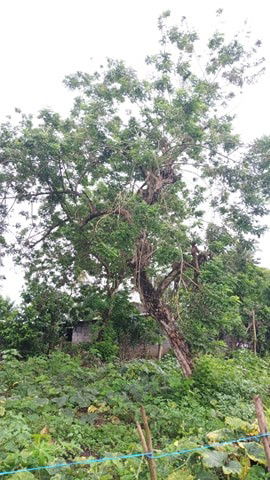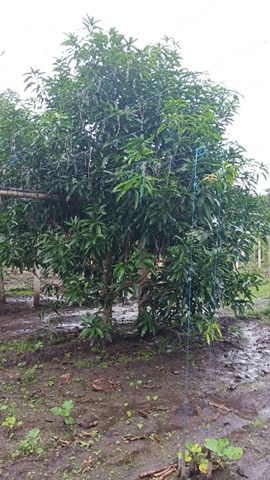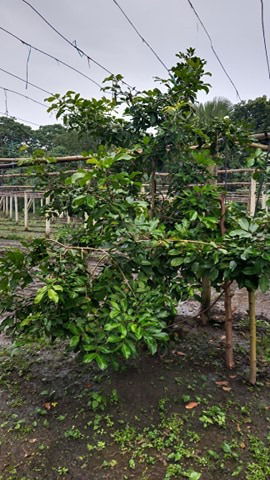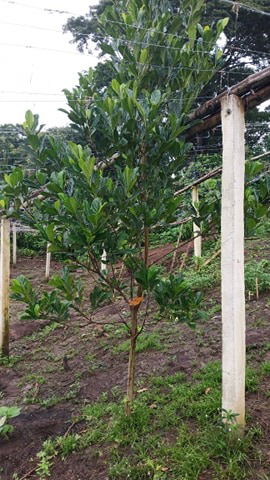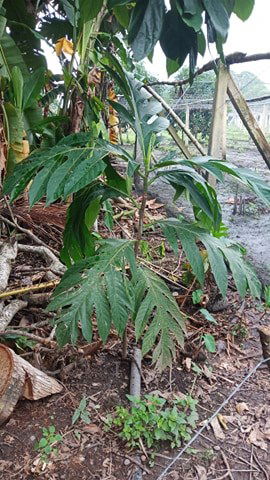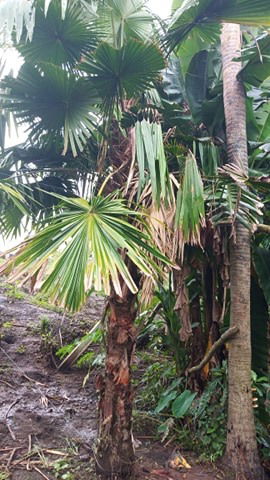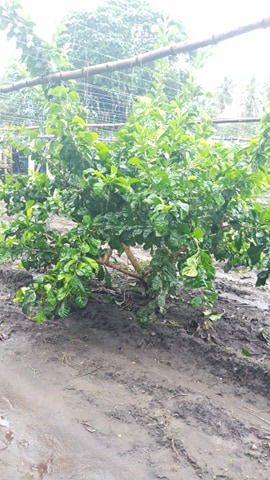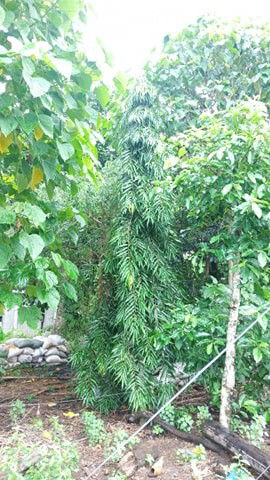DIGITAL TREE INVENTORY
ABOUT
Common names: Madreado
Scientific name: Gliricidia sepium
Historical Information: In many tropical and sub tropical countries, the tree is used for various purposes such as live fencing, fodder, coffee shade, firewood, green manure and rat poison. The tree can also be used for medicinal and insect repellant properties.
Scientific Information: Madre de Cacao is nitrogen-fixing tree that can grow from 10 to 12 meters high. The tree is referred by many people as a quick-stick due to the characteristic of growing almost right away just by cutting it and directly planting it in the ground. Adaptable to almost any soil environment including infertile soils, the tree is tolerant to salt spray and water logging and it can also tolerate drought for up to 6 to 8 months. This tree can be potentially weedy, but rarely causes a problem.
Number of representatives: 4
Scientific name: Gliricidia sepium
Historical Information: In many tropical and sub tropical countries, the tree is used for various purposes such as live fencing, fodder, coffee shade, firewood, green manure and rat poison. The tree can also be used for medicinal and insect repellant properties.
Scientific Information: Madre de Cacao is nitrogen-fixing tree that can grow from 10 to 12 meters high. The tree is referred by many people as a quick-stick due to the characteristic of growing almost right away just by cutting it and directly planting it in the ground. Adaptable to almost any soil environment including infertile soils, the tree is tolerant to salt spray and water logging and it can also tolerate drought for up to 6 to 8 months. This tree can be potentially weedy, but rarely causes a problem.
Number of representatives: 4
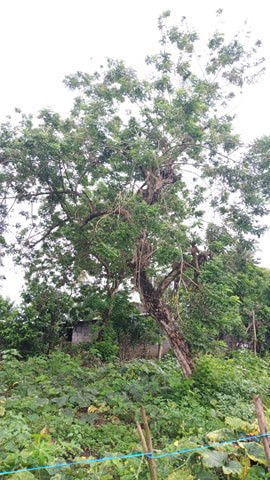
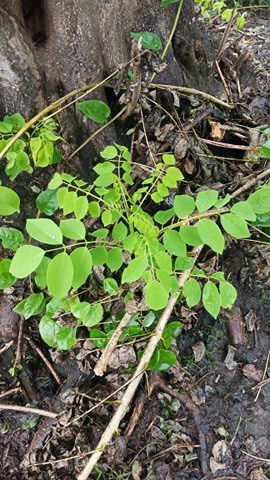
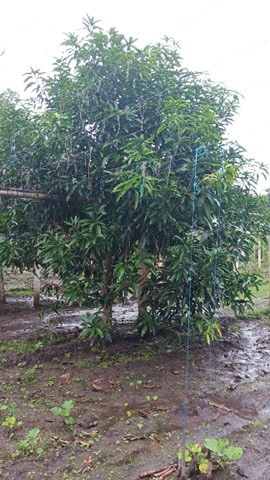
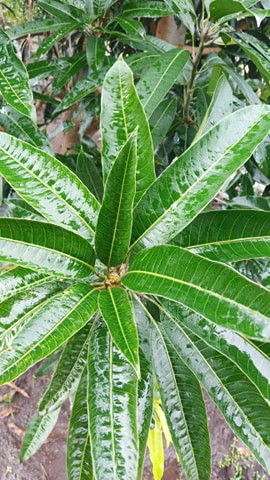
Scientific name: Mangifera indica
Historical Information: Mangoes are native to South Asia, from where the "common mango" or "Indian mango", Mangifera indica, has been distributed worldwide to become one of the most widely cultivated fruits in the tropics. The mango is native to southern Asia, especially Burma and eastern India. It spread early on to Malaya, eastern Asia and eastern Africa. Mangos were introduced to California (Santa Barbara) in 1880. Forms: The mango exists in two races, one from India and the other from the Philippines and Southeast Asia.
Scientific Information: the most economically important fruit crop in the Anacardiaceae (Cashew or poison ivy family). Other important members of this family include cashew, pistachio, and the mombins (Spondias spp.). The family contains 73 genera and about 600-850 species, with a few representatives in temperate regions, distinguished by their resinous bark and caustic oils in leaves, bark, and fruits. The other distant relatives of Mangifera are cashew (Anacardium occidentale), gandaria (Bouea gandaria), pistachio (Pistacia vera), marula (Sclerocarya birrea), ambarella (Spondias cytherea), yellow mombin (Spondias mombin), red mombin (Spondias purpurea), imbu (Spondias tuberosa), dragon plums (Dracontomelum spp.) kaffir plum (Harpepbyllum caffrum), etc. Malesia has been considered as the phytogeographic region extending from the Malay Peninsular south of the Kangar-Pattani line to the Bismarck archipelago east ofNew Guinea (Whitmore, 1975). Apart from edible fruit Anacardiaceous species also yield other valuable products like wood, gums and resins, wax and varnishes and tanning materials. Mangifera indica, commonly used herb in ayurvedic medicine. Although review articles on this plant are already published, but this review article is presented to compile all the updated information on its phytochemical and pharmacological activities, which were performed widely by different methods. Studies indicate mango possesses antidiabetic, anti-oxidant, anti-viral, cardiotonic, hypotensive, anti-inflammatory properties. Various effects like antibacterial, anti fungal, anthelmintic, anti parasitic, anti tumor, anti HIV, antibone resorption, antispasmodic, antipyretic, antidiarrhoeal, antiallergic, immunomodulation, hypolipidemic, anti microbial, hepatoprotective, gastroprotective have also been studied. These studies are very encouraging and indicate this herb should be studied more extensively to confirm these results and reveal other potential therapeutic effects. Clinical trials using mango for a variety of conditions should also be conducted
Number of representatives: 7
Common names: Rambutan
Scientific name: Nephelium lappaceum
Historical Information: a medium-sized tropical tree in the family Sapindaceae. The name also refers to the edible fruit produced by this tree. The rambutan is native to Southeast Asia.
Scientific Information: Nephelium lappaceum L. (Family- Sapindaceae), popularly known as ‘Rambutan’, is an evergreen tree, native to Malaysia but grown in other parts of the world. The plant has been used as traditional medicine for centuries especially as a remedy for diabetes and high blood pressure. Further, the fruits always remained as a potential source of minerals and other nutrients. A thorough literature survey revealed that the plant possesses several biological activities such as antidiabetic, analgesic, antiinflammatory, immunomodulatory, antioxidant, anticancer, antimicrobial and antiviral activities against dengue virus. This paper outlines an updated review on this important plant focusing on the traditional uses, phytochemistry and pharmacological aspects that would assist researchers to search scientific information in the future.
Number of representatives: 5
Scientific name: Nephelium lappaceum
Historical Information: a medium-sized tropical tree in the family Sapindaceae. The name also refers to the edible fruit produced by this tree. The rambutan is native to Southeast Asia.
Scientific Information: Nephelium lappaceum L. (Family- Sapindaceae), popularly known as ‘Rambutan’, is an evergreen tree, native to Malaysia but grown in other parts of the world. The plant has been used as traditional medicine for centuries especially as a remedy for diabetes and high blood pressure. Further, the fruits always remained as a potential source of minerals and other nutrients. A thorough literature survey revealed that the plant possesses several biological activities such as antidiabetic, analgesic, antiinflammatory, immunomodulatory, antioxidant, anticancer, antimicrobial and antiviral activities against dengue virus. This paper outlines an updated review on this important plant focusing on the traditional uses, phytochemistry and pharmacological aspects that would assist researchers to search scientific information in the future.
Number of representatives: 5
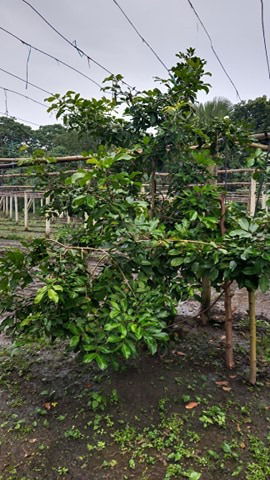
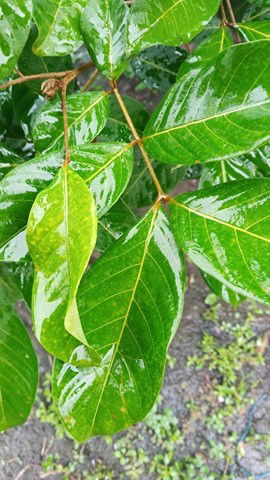
Common names: Jackfruit
Scientific name: Artocarpus heterophyllus
Historical Information: a species of tree in the fig, mulberry, and breadfruit family (Moraceae). Its origin is in the region between the Western Ghats of southern India and the rainforests of Malaysia.
Scientific Information: The jack tree is well-suited to tropical lowlands, and is widely cultivated throughout tropical regions of the world. It bears the largest fruit of all trees, reaching as much as 55 kg (120 pounds) in weight, 90 cm (35 inches) in length, and 50 cm (20 inches) in diameter. A mature jack tree produces some 200 fruits per year, with older trees bearing up to 500 fruits in a year. The jackfruit is a multiple fruit composed of hundreds to thousands of individual flowers, and the fleshy petals of the unripe fruit are eaten. The ripe fruit is sweet (depending on variety) and is more often used for desserts. Canned jackfruit has a mild taste and meat-like texture that lends itself to being called a "vegetable meat". Jackfruit is commonly used in South and Southeast Asian cuisines. Both ripe and unripe fruits are consumed. The jackfruit is the national fruit of Bangladesh and Sri Lanka, and the state fruit of the Indian states of Kerala and Tamil Nadu. It is available internationally canned or frozen and in chilled meals as are various products derived from the fruit such as noodles and chips.
Number of representatives: 1
Scientific name: Artocarpus heterophyllus
Historical Information: a species of tree in the fig, mulberry, and breadfruit family (Moraceae). Its origin is in the region between the Western Ghats of southern India and the rainforests of Malaysia.
Scientific Information: The jack tree is well-suited to tropical lowlands, and is widely cultivated throughout tropical regions of the world. It bears the largest fruit of all trees, reaching as much as 55 kg (120 pounds) in weight, 90 cm (35 inches) in length, and 50 cm (20 inches) in diameter. A mature jack tree produces some 200 fruits per year, with older trees bearing up to 500 fruits in a year. The jackfruit is a multiple fruit composed of hundreds to thousands of individual flowers, and the fleshy petals of the unripe fruit are eaten. The ripe fruit is sweet (depending on variety) and is more often used for desserts. Canned jackfruit has a mild taste and meat-like texture that lends itself to being called a "vegetable meat". Jackfruit is commonly used in South and Southeast Asian cuisines. Both ripe and unripe fruits are consumed. The jackfruit is the national fruit of Bangladesh and Sri Lanka, and the state fruit of the Indian states of Kerala and Tamil Nadu. It is available internationally canned or frozen and in chilled meals as are various products derived from the fruit such as noodles and chips.
Number of representatives: 1
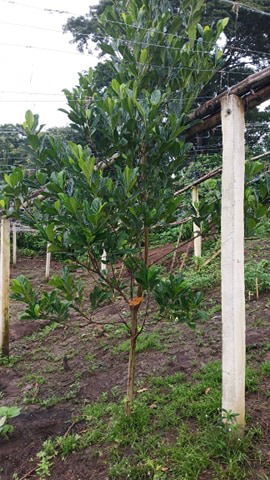
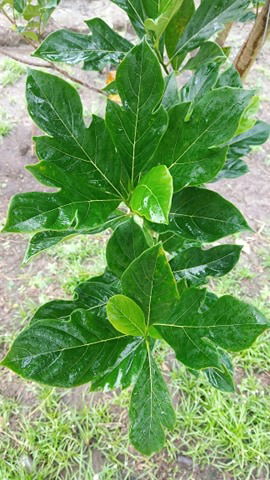
Common names: Breadnut/Breadfruit/camansi/pakak
Scientific name: Artocarpus camansi
Historical Information: a species of flowering tree in the mulberry and jackfruit (Artocarpus heterophyllus) family (Moraceae) believed to be a domesticated descendant of Artocarpus camansi originating in New Guinea, the Maluku Islands, and the Philippines.
Scientific Information: Artocarpus camansi, the breadnut, is species of medium-sized tree in the family Moraceae. It is native to New Guinea, the Maluku Islands, and the Philippines. It is the wild ancestor of the breadfruit (Artocarpus altilis) and is also sometimes known as the seeded breadfruit, to distinguish it from its mostly seedless descendant. Breadnut fruits are edible when cooked. The large seeds can also be roasted and eaten.
Number of representatives: 4
Scientific name: Artocarpus camansi
Historical Information: a species of flowering tree in the mulberry and jackfruit (Artocarpus heterophyllus) family (Moraceae) believed to be a domesticated descendant of Artocarpus camansi originating in New Guinea, the Maluku Islands, and the Philippines.
Scientific Information: Artocarpus camansi, the breadnut, is species of medium-sized tree in the family Moraceae. It is native to New Guinea, the Maluku Islands, and the Philippines. It is the wild ancestor of the breadfruit (Artocarpus altilis) and is also sometimes known as the seeded breadfruit, to distinguish it from its mostly seedless descendant. Breadnut fruits are edible when cooked. The large seeds can also be roasted and eaten.
Number of representatives: 4
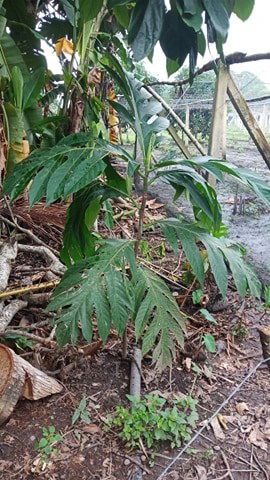
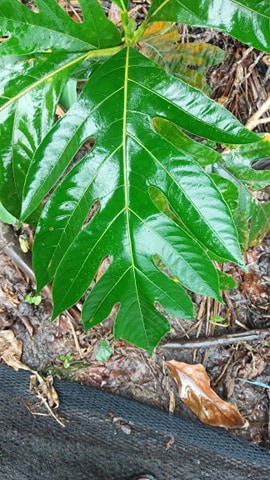
Common names: Kapok (Filipino); White satin cotton tree; White silk-cotton tree; Kapoktree; Silk cotton tree (English)
Scientific name: Eriodendrom pentandrum
Historical Information: seed-hair fibre obtained from the fruit of the kapok tree or the kapok tree itself. The kapok is a gigantic tree of the tropical forest canopy and emergent layer. Common throughout the tropics, the kapok is native to the New World and to Africa and was transported to Asia, where it is cultivated for its fibre, or floss.
Scientific Information: a tropical tree of the order Malvales and the family Malvaceae (previously separated in the family Bombacaceae), native to Mexico, Central America and the Caribbean, northern South America, and (as the variety C. pentandra var guineensis) to West Africa. A somewhat smaller variety is cultivated in southern and southeast Asia. Kapok is a name used in English speaking countries for both the tree and the cotton-like fluff obtained from its seed pods. In Spanish speaking countries the tree is commonly known as "ceiba". The tree is cultivated for the seed fibre, particularly in south-east Asia, and is also known as the Java cotton, Java kapok, silk-cotton or samauma.
Number of representatives: 2
Scientific name: Eriodendrom pentandrum
Historical Information: seed-hair fibre obtained from the fruit of the kapok tree or the kapok tree itself. The kapok is a gigantic tree of the tropical forest canopy and emergent layer. Common throughout the tropics, the kapok is native to the New World and to Africa and was transported to Asia, where it is cultivated for its fibre, or floss.
Scientific Information: a tropical tree of the order Malvales and the family Malvaceae (previously separated in the family Bombacaceae), native to Mexico, Central America and the Caribbean, northern South America, and (as the variety C. pentandra var guineensis) to West Africa. A somewhat smaller variety is cultivated in southern and southeast Asia. Kapok is a name used in English speaking countries for both the tree and the cotton-like fluff obtained from its seed pods. In Spanish speaking countries the tree is commonly known as "ceiba". The tree is cultivated for the seed fibre, particularly in south-east Asia, and is also known as the Java cotton, Java kapok, silk-cotton or samauma.
Number of representatives: 2

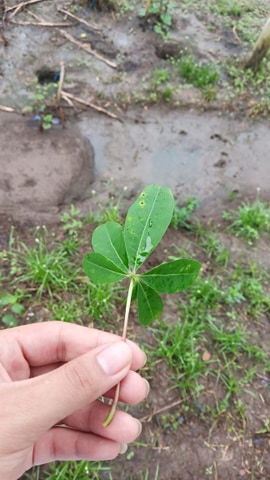
Common names: round-leaf fountain palm
Scientific name: Saribus rotundifolius
Historical Information: a common fan palm found in Southeast Asia. It is a member of the genus Saribus.
Scientific Information: a hermaphrodite fan palm. The palm is evergreen, erect, and only grows having a single trunk ('solitary'). It grows at a height ranging from 15 to 25 metres, exceptionally up to 45 metres tall, and thickness of 15 to 25 cm diameter at breast height.
Number of representatives: 2
Scientific name: Saribus rotundifolius
Historical Information: a common fan palm found in Southeast Asia. It is a member of the genus Saribus.
Scientific Information: a hermaphrodite fan palm. The palm is evergreen, erect, and only grows having a single trunk ('solitary'). It grows at a height ranging from 15 to 25 metres, exceptionally up to 45 metres tall, and thickness of 15 to 25 cm diameter at breast height.
Number of representatives: 2
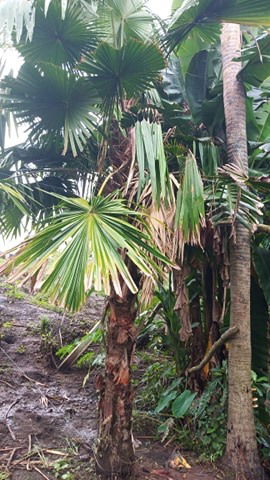

Common names: Asoka tree
Scientific name: Polyalthia longifolia (Sonn.) Thwaites
Historical Information: An Account of Trees, Shrubs, Woody Climbers, Bamboos, and Palms Indigenous or Commonly Cultivated in the British Indian Empire is a monograph on the trees of India.
Scientific Information: Polyalthia longifolia is a species of tree in the family Annonaceae. It has a self-supporting growth form. It has simple, broad leaves. Polyalthia longifolia is a photoautotroph.
Number of representatives: 3
Scientific name: Polyalthia longifolia (Sonn.) Thwaites
Historical Information: An Account of Trees, Shrubs, Woody Climbers, Bamboos, and Palms Indigenous or Commonly Cultivated in the British Indian Empire is a monograph on the trees of India.
Scientific Information: Polyalthia longifolia is a species of tree in the family Annonaceae. It has a self-supporting growth form. It has simple, broad leaves. Polyalthia longifolia is a photoautotroph.
Number of representatives: 3
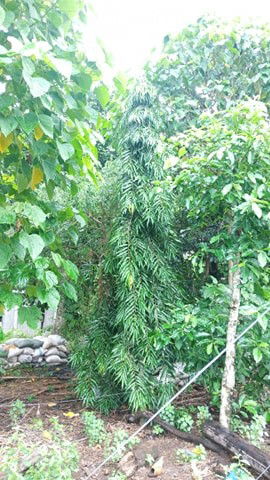
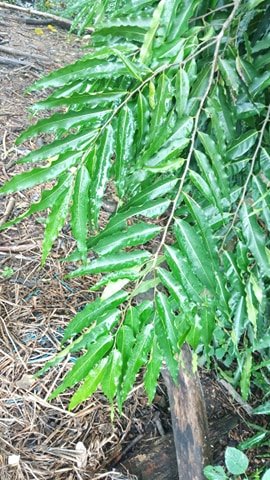
Common name: miracle berry
Scientific name: Synsepalum dulcificum
Historical Information: its mild fruits that make subsequently eaten sour foods taste sweet. The miracle fruit plant is native to tropical West Africa, where it is used locally to sweeten palm wine and other beverages.
Scientific Information: The miracle fruit plant grows as a dense shrub or small tree, usually not more than 5.5 metres (18 feet) in height in the wild and generally smaller when cultivated. The simple leaves are oval and tapering at the base with smooth margins and feature a waxy underside; they grow in spirelike clusters at the ends of small branches. The small white flowers give rise to red drupe fruits that are about 2–3 cm (0.8–1.2 inches) in length. Plants typically begin producing fruit after three or four years and require acidic soil.
Number of representatives: 1
Scientific name: Synsepalum dulcificum
Historical Information: its mild fruits that make subsequently eaten sour foods taste sweet. The miracle fruit plant is native to tropical West Africa, where it is used locally to sweeten palm wine and other beverages.
Scientific Information: The miracle fruit plant grows as a dense shrub or small tree, usually not more than 5.5 metres (18 feet) in height in the wild and generally smaller when cultivated. The simple leaves are oval and tapering at the base with smooth margins and feature a waxy underside; they grow in spirelike clusters at the ends of small branches. The small white flowers give rise to red drupe fruits that are about 2–3 cm (0.8–1.2 inches) in length. Plants typically begin producing fruit after three or four years and require acidic soil.
Number of representatives: 1
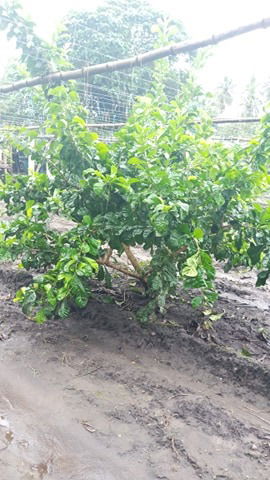
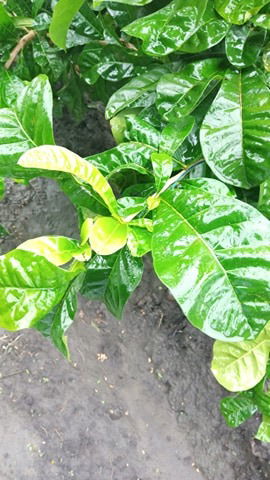
Common names: papaya
Scientific name: Carica papaya
Historical Information: succulent fruit of a large plant of the family Caricaceae. Though its origin is rather obscure, the papaya may represent the fusion of two or more species of Carica native to Mexico and Central America.
Scientific Information: The papaya plant is considered a tree, though its palmlike trunk, up to 8 metres (26 feet) tall, is not as woody as the designation generally implies. The plant is crowned by deeply lobed leaves, sometimes 60 cm (2 feet) across, borne on hollow petioles (leaf stalks) 60 cm long. Normally, the species is dioecious, male and female flowers being produced on separate plants, but hermaphroditic forms are known, and numerous irregularities in the distribution of the sexes are common. Male flowers are borne in clusters on stalks 90 cm long; the flowers are funnel-shaped, about 2.5 mm (0.1 inch) long, and whitish, with 10 stamens in the throat. The female flowers are considerably larger, on very short stalks, and often solitary in the leaf axils; they have five fleshy petals that are united toward the base and a large cylindrical or globose superior ovary that is crowned by five fan-shaped sessile stigmas.
Number of representatives: 1
Scientific name: Carica papaya
Historical Information: succulent fruit of a large plant of the family Caricaceae. Though its origin is rather obscure, the papaya may represent the fusion of two or more species of Carica native to Mexico and Central America.
Scientific Information: The papaya plant is considered a tree, though its palmlike trunk, up to 8 metres (26 feet) tall, is not as woody as the designation generally implies. The plant is crowned by deeply lobed leaves, sometimes 60 cm (2 feet) across, borne on hollow petioles (leaf stalks) 60 cm long. Normally, the species is dioecious, male and female flowers being produced on separate plants, but hermaphroditic forms are known, and numerous irregularities in the distribution of the sexes are common. Male flowers are borne in clusters on stalks 90 cm long; the flowers are funnel-shaped, about 2.5 mm (0.1 inch) long, and whitish, with 10 stamens in the throat. The female flowers are considerably larger, on very short stalks, and often solitary in the leaf axils; they have five fleshy petals that are united toward the base and a large cylindrical or globose superior ovary that is crowned by five fan-shaped sessile stigmas.
Number of representatives: 1
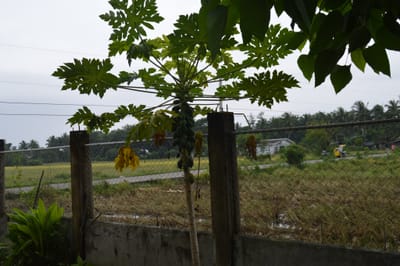
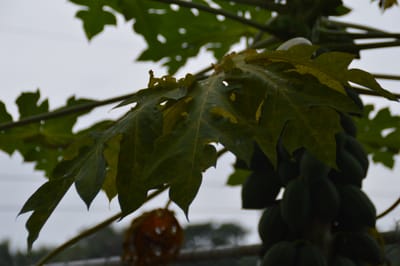
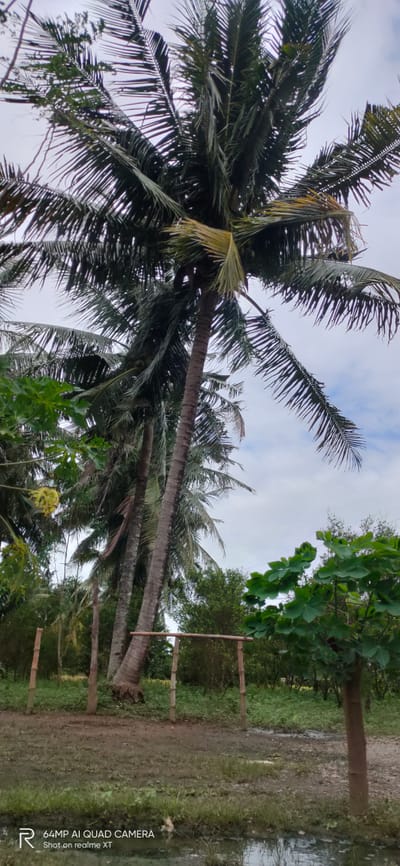

Scientific name: Coco nucifera L.
Other Scientific Names; Calappa nucifera (L.) Kuntze, Cocos indica Royle, Cocos nana Griffith, Cocos nucifera var. synphyllica Becc.
Historical Information: Literary evidence from the Ramayana and Sri Lankan chronicles indicates that the coconut was present in the Indian subcontinent before the 1st century BCE.[12] The earliest direct description is given by Cosmas Indicopleustes in his Topographia Christiana written around 545, referred to as "the great nut of India".[13] Another early mention of the coconut dates back to the "One Thousand and One Nights" story of Sinbad the Sailor wherein he bought and sold a coconut during his fifth voyage.[14] In March 1521, a description of the coconut was given by Antonio Pigafetta writing in Italian and using the words "cocho"/"cochi", as recorded in his journal after the first European crossing of the Pacific Ocean during the Magellan circumnavigation and meeting the inhabitants of what would become known as Guam and the Philippines. He explained how at Guam "they eat coconuts" ("mangiano cochi") and that the natives there also "anoint the body and the hair with coconut and beniseed oil" ("ongieno el corpo et li capili co oleo de cocho et de giongioli")
Scientific Information: widespread fruit plant on Earth. Throughout history, humans have used medicinal plants therapeutically, and minerals, plants, and animals have traditionally been the main sources of drugs. The constituents of C. nucifera have some biological effects, such as antihelminthic, anti-inflammatory, antinociceptive, antioxidant, antifungal, antimicrobial, and antitumor activities. Our objective in the present study was to review the phytochemical profile, pharmacological activities, and toxicology of C. nucifera to guide future preclinical and clinical studies using this plant. This systematic review consisted of searches performed using scientific databases such as Scopus, Science Direct, PubMed, SciVerse, and Scientific Electronic Library Online. Some uses of the plant were partially confirmed by previous studies demonstrating analgesic, antiarthritic, antibacterial, antipyretic, antihelminthic, antidiarrheal, and hypoglycemic activities. In addition, other properties such as antihypertensive, anti-inflammatory, antimicrobial, antioxidant,
Number of representatives: 14
